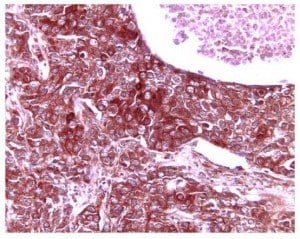 Researchers from the Stanford University School of Medicine have discovered that the artificial activation of an important molecular pathway could someday be used to treat various diseases. The pathway is responsible for decreases in the growth of cells that produce insulin, and is activated naturally as an individual grows older. The findings were published in the October 12 edition of the journal “Nature.”
Researchers from the Stanford University School of Medicine have discovered that the artificial activation of an important molecular pathway could someday be used to treat various diseases. The pathway is responsible for decreases in the growth of cells that produce insulin, and is activated naturally as an individual grows older. The findings were published in the October 12 edition of the journal “Nature.”
The pathway being studied appears in both mice and humans. It is activated by the expression of a particular molecule called platelet-derived growth factor receptor, or PDGF-receptor for short. Expression of this molecule naturally decreases over time, as does the growth of beta cells in the pancreas, which release insulin that helps removes glucose from the bloodstream and transports it to cells where it can be used as energy.
Scientists have long known that the growth of pancreatic beta cells decreases dramatically over time. In young and newborn humans and animals, beta cell proliferation is abundant.
Another molecule known as Ezh2 appears to be involved in the pathway that reduces production of beta cells, as expression of the molecule decreases over time. Scientists were unaware, however, what caused the change in expression of Ezh2.
Researchers on the study discovered that, in juvenile mice, the expression of PDGF receptors was reduced in the islet cells of the pancreas in a similar pattern to that of the decreases in beta cell production.
Blocking the expression of PDGF receptors in young lab mice—two to three weeks old—caused decreases in Ezh2 production and the number of pancreatic beta cells than control animals whose PDGF receptors were not affected. The mice with reduced Ezh2 production also demonstrated slightly higher blood sugar levels than control subjects and could not remove glucose from the blood stream as effectively when they were given a high glycemic load, such as after a meal heavy in carbohydrates.
A lack of expression in PDGF receptors also affected fully-grown lab mice: their ability to replace beta cells was diminished when the cells were destroyed by a compound that the researchers administered to the animals. They also developed severe diabetes after their beta cells were destroyed.
“We’re hopeful that soon we might be able to manipulate this pathway in a therapeutic way in humans,” said Seung Kim, M.D., Ph.D., senior author of the study and a professor of developmental biology at Stanford University. Kim believes that scientists may one day develop a therapy that activates the pathway to promote the regrowth of beta cells or prevent their destruction.
“Perhaps by rekindling its expression and then activating it through a drug we could give in an injection or through some other route. This could be a kind of one-two punch against diabetes,” continued Kim.
If scientists can develop a therapy that promotes growth of beta cells, it could offer a new method of treating or preventing diabetes that differs from current therapeutics, which mostly focus on maintaining healthy blood glucose levels. Replacing pancreatic beta cells could allow the body to produce its own insulin to regulate blood glucose instead of relying on insulin injections or other medication to control blood sugar.
“This gives us a handhold onto a vaster problem: how to control human beta cell proliferation in a therapeutic way,”
Additionally, the researchers commented that they found other molecular patheways related to the loss of beta cells due to aging that have not yet been explored.